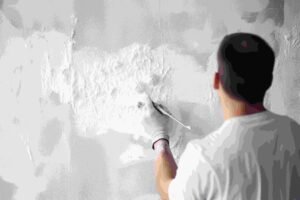Introduction to Paints and Architectural Coatings
Paints and architectural coatings have played a pivotal role in the evolution of construction, art, and design. Essentially, paints are liquids or substances that, when applied to a surface, form a solid film that provides both protection and color. Architectural coatings, a broader term, encompass paints as well as other specialty coatings applied to buildings and structures to enhance durability, appearance, and functionality.
In their most basic form, paints and coatings are composed of four main components: pigments, binders, solvents, and additives. Pigments provide color and opacity; binders, often referred to as resins, help the pigment particles adhere to the surface and provide the film’s durability; solvents typically function as the medium that carries the pigment and binder until it evaporates, leaving the solid film; and additives improve various properties like drying time, resistance to fungi, and UV stability.
The history of paints dates back to prehistoric times when early humans used natural materials like charcoal, ochre, and iron oxides to create the first rudimentary paints. The Egyptians and Greeks made significant advancements, utilizing natural materials like beeswax and egg yolk. The Industrial Revolution brought about synthetic pigments and resins, revolutionizing the variety, quality, and commercial availability of paints and architectural coatings.
In modern construction and design, these materials are indispensable. Not only do they protect surfaces from environmental factors such as moisture, UV radiation, and chemical exposure, but they also contribute to the aesthetic appeal of living and working spaces. Innovations such as low-VOC (volatile organic compounds) formulas have catered to growing environmental and health concerns, highlighting the industry’s adaptability and responsiveness to contemporary demands.
Types of Paints and Their Applications
Understanding the various types of paints available in the market is essential for making informed decisions on your next painting project. Each type of paint possesses distinct characteristics that make it suitable for specific applications. Among the most commonly used are acrylic, oil-based, latex, and enamel paints.
Acrylic paints, known for their quick-drying properties, are versatile and can be used on numerous surfaces such as wood, metal, and masonry. These paints are also water-based, making them easy to clean with soap and water. They offer excellent color retention and flexibility, which helps resist cracking and fading over time. Consequently, acrylic paints are often preferred for interior walls and ceilings.
Oil-based paints, while not as popular as they once were, still serve specific purposes, particularly in high-traffic areas. They offer a durable and smooth finish, capable of withstanding wear and tear. However, their slow drying time and strong odor are notable disadvantages. Cleaning up requires solvents like turpentine, making them less environmentally friendly. Despite these drawbacks, they are commonly used for trim, doors, and areas requiring a hard, robust finish.
Latex paints, also water-based, are favored for their flexibility and ease of use. These paints dry relatively quickly and are available in a wide range of finishes from matte to high gloss. Latex paints are less prone to yellowing over time and clean up easily with water. They are ideal for both interior and exterior applications, including walls, ceilings, and exterior siding.
Enamel paints stand out for their high durability and glossy finish. Often used for trim, doors, and cabinets, these paints provide a tough coating resistant to moisture and wear. Enamel paints come in both water-based and oil-based formulations, offering flexibility in usage based on specific requirements.
Each type of paint has its unique advantages and disadvantages, making it essential to choose appropriately based on the surface being painted and the intended use. Whether you are working on an interior residential project or an exterior commercial building, understanding the properties of these paints will guide you in selecting the most suitable option.

Architectural coatings play a pivotal role in both residential and commercial construction, offering not only aesthetic benefits but also essential protective features. These coatings come in various types, each tailored for specific applications and desired outcomes.
Primers
Primers are the preparatory coatings applied to substrates before the topcoat. They ensure better adhesion of paint to the surface, increase paint durability, and provide additional protection for the material being painted. By sealing the substrate, primers improve the overall appearance and longevity of the topcoat. They are especially crucial for porous materials like wood and drywall, as they prevent the paint from being absorbed unevenly.
Varnishes
Varnishes are transparent, hard, protective finishes or films primarily used in wood finishing but also applicable to other materials. They enhance the natural beauty of wood by adding a glossy or satin sheen while providing protection against scratches, UV damage, and moisture. Varnishes are typically found in both interior and exterior applications. Their ability to resist heat and chemicals makes them ideal for surfaces subjected to heavy use and environmental stress.
Specialty Coatings
Specialty coatings are formulated for specialized applications and environments. These include waterproofing coatings, anti-graffiti coatings, fire-retardant coatings, and anti-corrosion coatings. Each of these products addresses unique challenges, providing tailored solutions to enhance durability, safety, and maintenance. For instance, fire-retardant coatings are designed to reduce the spread of flames, providing critical time in emergency situations.
Innovations in Technology
Ongoing advancements in technology have significantly improved the performance of architectural coatings. Innovations such as low-VOC (volatile organic compounds) formulations have made coatings more environmentally friendly, reducing health risks and minimizing ecological impacts. Nanotechnology has also introduced coatings with enhanced properties such as self-cleaning, anti-microbial, and ultra-durable finishes. These modern coatings not only meet increasing regulatory standards but also cater to the demand for higher-performing and more sustainable products.
The development and application of primers, varnishes, and specialty coatings demonstrate the integral role they play in the building industry, offering essential protection, aesthetic enhancement, and extended durability to a variety of surfaces.
Choosing the Right Paint and Coating for Your Project
Selecting the appropriate paint or coating for a project involves careful consideration of various factors such as surface material, environmental conditions, and the desired finish. Understanding these nuances can greatly influence the durability and aesthetic appeal of the final outcome.
The first step in choosing the right paint or coating is identifying the type of surface you will be working on. Different materials, such as wood, metal, concrete, or drywall, require specific types of paints or coatings to ensure proper adhesion and long-lasting results. For instance, wood surfaces often benefit from latex or oil-based paints, which provide strong coverage and durability, while metal surfaces typically require specialized primers and rust-resistant coatings.
Environmental conditions also play a critical role in paint selection. Exterior projects demand paints that can withstand weather elements like rain, UV radiation, and temperature fluctuations. Paints labeled as “exterior” are formulated to resist fading, cracking, and peeling, ensuring the coating remains intact over time. Conversely, interior paints are designed to endure less severe wear and tear but should still be chosen based on specific room requirements, such as moisture resistance for bathrooms and kitchens or low-VOC formulations for improved indoor air quality.
Another important consideration is the desired finish, which can range from matte to high-gloss. Each finish provides different aesthetic qualities and practical benefits. For example, high-gloss paints are ideal for high-traffic areas due to their easy-clean properties, while matte finishes help conceal surface imperfections and offer a more subdued, elegant look.
When evaluating paint brands, it is crucial to compare not only price but also quality and durability. Reading product reviews, consulting professionals, and understanding labels can provide insights into the performance of different brands. Additionally, eco-friendly paints, which contain fewer volatile organic compounds (VOCs), have emerged as a popular choice, offering health benefits and reduced environmental impact without compromising quality.
In making an informed decision, consider these multifaceted factors to ensure that the paint or coating you choose aligns with the specific needs of your project, ultimately enhancing both functionality and aesthetic appeal.


The Importance of Surface Preparation
Surface preparation is a critical step in ensuring the successful application of paints and architectural coatings. Properly prepared surfaces not only enhance the adhesion of the coatings but also prolong their durability and appearance. Whether painting walls, wood, or metal, the process begins with thorough cleaning to remove any dirt, grease, or loose particles that could interfere with the coating’s ability to bond.
Cleaning methods vary depending on the surface. For walls, a mild detergent solution and a scrub brush are typically sufficient. For more challenging surfaces like metal, degreasers or solvents may be required to remove oil and residues. Once cleaned, surfaces might also need to be dried completely to ensure a moisture-free painting environment.

Sanding is another vital step in surface preparation, particularly for surfaces that are rough or glossy. Sanding helps to create a smooth and even surface, allowing the paint to adhere more effectively. For wooden surfaces, using fine-grit sandpaper can eliminate imperfections and signs of previous coatings. Metal surfaces may require sanding to remove rust or old paint layers.
Applying a primer is often the final step in the preparation process. Primers serve as a foundation for the paint, sealing the surface and providing a uniform base that improves adhesion and extends the life of the paint job. For porous surfaces like wood or unpainted drywall, primers are especially crucial as they prevent the paint from being absorbed unevenly.
Avoiding common mistakes during surface preparation can save time and ensure a smoother finish. One frequent error is neglecting to clean the surfaces adequately, which can lead to peeling and poor adhesion of the paint. Another typical mistake is skipping the sanding step, resulting in an uneven texture. Finally, using the wrong type of primer or omitting it altogether can compromise the integrity of the entire painting project.
The right tools are essential for effective surface preparation. Basic supplies like scrub brushes, sandpaper of varying grits, and high-quality primers are indispensable. For extensive projects, investing in power sanders and specialized cleaning solutions can expedite the process and deliver consistently superior results.
Application Techniques and Tools
Applying paints and architectural coatings requires an understanding of the three primary methods: brushing, rolling, and spraying. Each technique offers unique benefits and is suitable for specific tasks. Selecting the right method and tools significantly impacts the final result, ensuring a professional and durable finish.
Brushing is a popular method for precision work, such as painting trim, corners, and small areas. High-quality brushes with synthetic or natural bristles are essential for achieving a smooth, even finish. When brushing, apply paint in long, even strokes, consistently overlapping to avoid visible brush marks and streaks. Regularly cleaning brushes throughout the job can also prevent hardened paint from disrupting the surface texture.
Rolling is ideal for covering large, flat surfaces quickly, such as walls and ceilings. Selecting the proper roller cover material, nap length, and roller frame quality is crucial. For smoother surfaces, use a roller with a shorter nap, while rough or textured surfaces benefit from a longer nap. When rolling, maintain a wet edge by working in small sections and overlapping each pass to ensure uniform coverage and avoid lap marks. Rolling in an M or W pattern initially distributes paint more evenly, followed by rolling vertically to smooth out the finish.
Spraying offers the quickest application method, well-suited for large areas or intricate designs. This technique requires careful setup and practice to master. Choose an appropriate spray tip and adjust the pressure settings to match the paint’s viscosity. Maintain a consistent hand motion, holding the spray gun at a steady distance from the surface, and overlap each pass by about 50% to achieve an even coat. Adequate ventilation and masking off non-paintable areas are vital to avoid overspray and ensure safety.
Regardless of the chosen method, selecting high-quality tools appropriate for the specific job is vital. Common issues such as streaks, uneven coverage, or roller marks can often be avoided by investing in reliable brushes, rollers, and sprayers. Additionally, always follow safety precautions, such as wearing protective gear, ensuring good ventilation, and properly handling and storing paint and tools.
Maintenance and Longevity of Painted and Coated Surfaces
Maintaining and extending the life of painted and coated surfaces involves a combination of regular care and timely interventions. Regular cleaning is fundamental to preserving the aesthetic and protective qualities of the surface. For exterior surfaces, it is advisable to wash them at least once a year using mild soap, water, and a soft brush. This practice helps in removing dirt, mildew, and other contaminants that can deteriorate the paint or coating. Interior surfaces also benefit from routine dusting, wiping with a damp cloth, and spot cleaning to eliminate stains.
Touch-ups are crucial in managing minor wear and damage before they escalate. For small chips and scratches, it is recommended to use matching paint or coating to seamlessly cover the affected areas. Specialized touch-up kits or pens specific to the surface material are also available, ensuring a professional finish. For larger repairs, especially on high-traffic surfaces, sand the damaged area lightly before applying the touch-up, and always follow the manufacturer’s instructions for best results.
Dealing with wear and damage involves recognizing when a repaint or recoating is necessary. Caulking cracks, peeling, or significant fading are indicators that the surface might need a fresh coat. It’s essential to select high-quality products for repainting or recoating, as these offer better adhesion, durability, and resistance to environmental stressors. Brands that are frequently recommended include Sherwin-Williams, Benjamin Moore, and Behr for their reliable performance and extensive color palettes.
Product recommendations for maintenance are varied, but opting for cleaning agents that are gentle yet effective is key. Among popular choices are Krud Kutter for general cleaning and Goo Gone for tougher stains. To protect painted and coated surfaces, consider applying a protective sealant every few years, particularly for exterior surfaces exposed to harsh weather conditions.
Lastly, staying proactive by performing routine inspections can save time and costs associated with major repairs. Recognize signs of deterioration early and take action promptly to maintain the longevity and appearance of your painted and coated surfaces.
Future Trends in Paints and Architectural Coatings
The paints and architectural coatings industry is on the cusp of significant transformation, driven by various emerging trends that promise to enhance both functionality and environmental sustainability. As consumers and businesses alike demand greener alternatives, there is a marked shift towards the development and adoption of sustainable and eco-friendly paints. These products are formulated with reduced Volatile Organic Compounds (VOCs), ensuring minimal environmental impact and enhanced indoor air quality.
Another fascinating trend is the advent of smart coatings. These advanced materials possess functionalities far beyond traditional paints. For example, photochromic coatings can change color based on light exposure, while thermochromic coatings adjust their hue according to temperature variations. Similarly, self-cleaning coatings, which incorporate nanotechnology, provide surfaces that repel dirt and grime, drastically reducing maintenance requirements. Such innovations, propelled by rapid technological advancements, are being embraced across residential, commercial, and industrial sectors.
Technological innovation plays a pivotal role in driving these new trends. The integration of Artificial Intelligence (AI) and the Internet of Things (IoT) in the production and application processes has streamlined operations, ensuring higher precision and efficiency. AI-driven predictive models and IoT-enabled sensors now allow for real-time monitoring of paint applications, optimizing resource use and minimizing waste.
Industry experts highlight the potential impact of these trends on various sectors. In construction, eco-friendly paints and smart coatings can contribute to green building certifications, such as LEED. In the automotive industry, functional coatings enhance vehicle durability and aesthetics. The manufacturing sector benefits from protective coatings that extend the lifecycle of machinery, ultimately improving cost efficiency.
As we look towards the future, the paints and architectural coatings industry is poised for an era marked by innovation and sustainability. These trends not only cater to the evolving needs of consumers and industries but also pave the way for a more responsible and intelligent approach to building and design.

